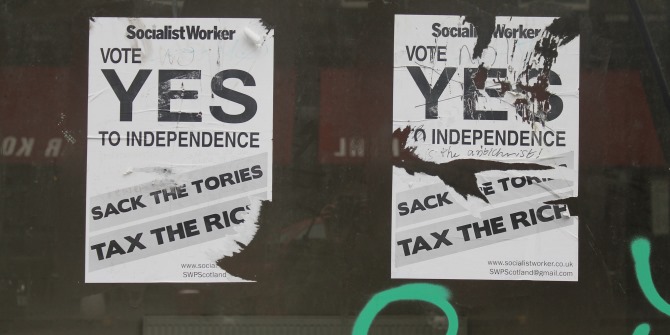Lewis Bassett discussess the organisational changes that took place within Labour under Jeremy Corbyn’s leadership. He argues these reforms were a house of cards that now appears ready to collapse, leaving little in its wake.
Politically, Jeremy Corbyn may have been right when he said that Labour under his leadership had ‘won the argument’. The current contenders to replace him are all far to the left of those who stood in 2015. And signs that the Conservatives are willing to tax and spend a little more, as well as borrow and invest, are policies that since early 2016 had been the life blood of ‘Corbynomics’ (although the more innovative and transformative side of this agenda – Labour’s industrial strategy, for example – are absent). Austerity, too, is not what it used to be with both voters and economic elites changing their former preferences.
But constitutionally, Corbyn will leave the Labour Party in a similar state to how he found it. Despite all the talk of democratisation that accompanied his leadership, very little has actually taken place. In September 2017, Corbyn announced a Democracy Review that would be a precursor to sweeping party reforms. Most Labour leaders tend to conduct such reviews but only Corbyn had promised to put ‘members at the heart of the party’. The Review captured over 11,000 submissions, including from Labour’s complex web of affilated organisations and trade unions; it was nevertheless rushed owing to perceptions of the need to stabilise Corbyn’s mantle and was ultimately watered down by the party’s National Executive Committee (NEC).
In 2018, at Labour’s conference – nominally the party’s sovereign body – delegates could vote on a package of rule changes drawn up by the NEC, rather than the direct recommendations of the Review. The result was little more than tinkering. On important issues, such as the number of seats on the NEC or the rules for leadership elections, small changes widened the franchise to give greater power mainly to the party’s affiliated trade unions.
The issue of how Labour selects its candidates for Westminster was a live topic since the moment Corbyn found himself on the leadership ballot in 2015. Reform here was also an outcome of conference in 2018, although not the purvey of the Review. These changes again testified to the party’s pluralism, giving greater power to local branches (both members and unions) to ‘trigger’ a sitting MP to face a local contest before standing for Labour in a general election. The proof of radicalism, however, was in the eating: before the 2019 general election, only six out of a total 242 sitting Labour MPs faced such a contest, including the Corbyn-loyalist Kate Osamor. Of this, two survived their members’ votes and the rest, other than Roger Godsiff, were re-imposed by the NEC without a choice. Considering how the whip was withdrawn from 21 Conservative MPs last year, Boris Johnson achieved more for party discipline in a single day than Corbyn did in nearly five years.
At the local level, there has been little change in the political composition of Labour councils, typically considered the domain of the party’s ‘old right’. Regional offices have remained largely unaltered. As for the Labour’s HQ in London, a very slow move away from New Labour’s bureaucratic legacy has occurred, including the party’s general secretary being drawn from the sympathetic trade union Unite. However, these changes are unstable, especially where employment contracts for central office staff are fixed-term.
Of course, Corbyn’s support has always been strongest among the members, yet here too the picture is increasingly mixed. In order to understand this, a distinction must be drawn between the organisation of members at the local level and their preferences as individuals, registered in one-member-one-vote (OMOV) plebiscites. Although historically introduced to undermine the party’s left, Corbyn supporters were always stronger in the latter.
So much, in fact, seems clear in the current state of local party ‘nominations’ for future leader (the final outcome of which is decided by an OMOV ballot). Among local branches, Rebecca Long-Bailey, seen to be the Corbyn-continuity candidate, trails behind Keir Starmer, the man who led Labour in the direction of a second referendum on Brexit. More worrying for Corbyn supporters, however, will be that Starmer’s lead over Long-Bailey is reflected in polling of members as well. The Corbyn movement appears to be shrinking among members, potentially costing it the leadership.
The slim majority of Corbyn’s supporters on the NEC is under threat as well, but not only as a result of a shift in members’ preferences. After two Corbyn-supporting delegates on the committee became MPs in 2019, an OMOV by-election for their replacement has seen division appear over exactly who would be the left’s candidate, with the preferences of the pro-Corbyn Momentum clashing with those of other left-wing factions. On 7 February, Labour’s compliance unit suspended two of the left-wing candidates, one of whom was previously embroiled in the party’s anti-Semitism crisis – an area where a distinct lack of leadership continues to cause havoc among the Corbyn movement’s grassroots.
Although pending the result of the leadership contest in early April, there is already enough evidence to suggest a major weakness of the Corbyn movement among members. In this light, the political commitments of the latter appear to have been centred upon one man, rather than any deeper socialist ideology, such as Long-Bailey claims to represent.
Ideologically, history may judge the Corbyn-movement harshly in terms of deepening members’ commitment to socialism, insofar as that was actually the goal. Momentum may have taken its members for granted, depending on them for donations, votes, likes and shares but failing to generate deeper and broader levels of ideological engagement. Such a task, in a post-modern, individualised context, without strong trade unions or significant class conflict, may be hard to achieve at scale, perhaps impossible. On the continent, ‘left populists’ (as Corbyn was also branded by his staff) like Podemos in Spain or La France Insoumise have also struggled to develop and sustain deep roots, both ideologically and institutionally. It is Britain’s majoritarian electoral system that explains the appearance of a renewed anti-austerity left inside of Labour, rather than the taking shape of a new insurgent party.
________________
Lewis Bassett is a PhD researcher in the Department of Sociology at the University of Manchester.
All articles posted on this blog give the views of the author(s), and not the position of LSE British Politics and Policy, nor of the London School of Economics and Political Science. Featured image credit: Jack Hamilton on Unsplash.







